Ferrari has announced the extreme version of its LaFerrari, it’s called the FXX K. Designed for track use only and described by Ferrari as a “laboratory-car” the FXX K has limitations only placed by Ferrari, no competition or road standards apply here.
The V12 hybrid produces 772kW (1050CV), a pleasant 64kW increase over the LaFerrari. The bulk of that increase has come from the 6.2 litre V12, which now pumps out a maximum 632kW (860CV), up from 588kW (800CV). Those gains have been made in part thanks to reworked intake manifolds, a modified valve train and the removal of mufflers from the exhaust. Oh yes, it will be loud!
At this stage no performance figures have been published. Although, to be fair, the car is in its early stages here and hasn’t actually been released for sale to Ferrari’s chosen few. For now, we just have to make do with rumours of a previously unimaginable Nürburgring lap time (6:35).
You can see in these few pictures that Ferrari has given the LaFerrari’s aero package a pretty solid makeover. The bodywork is now 30mm lower at the front and inspired by Ferrari’s knowledge gained from GT racing in the WEC. Those small rear wings also do more than it appears they would and complement the extreme rear diffuser.
All told downforce has been increased by around 50% when in low drag spec and 30% in high drag configuration. To put that into clearer numbers, the FXX K creates 540kg of downforce at 200km/h.
Running on Pirelli slicks and with recalibrated electronic control systems designed for trackday fun this is one multi-million dollar Ferrari we would all love to drive!
World premiere of the FXX K at the Ferrari Finali Mondiali in Abu Dhabi
Maranello, 2 December 2014 – Ferrari’s new FXX K research and development programme receives its world premiere next weekend at the Yas Marina Circuit in Abu Dhabi. The laboratory-car is based on Maranello’s first hybrid model and will grace the world’s tracks from next year onwards. The K in its moniker is a reference to the “KERS†kinetic energy recovery system it adopts in maximising its track performance.
Unfettered by homologation and racing regulations, the FXX K will never be used in competition. It was, in fact, developed to be completely uncompromising, incorporating technological innovations that will guarantee an unprecedented driving experience to the exclusive group of Client-Test Drivers with whom the Prancing Horse will roll out a test programme over the coming two years.
The car’s enormous potential is attested to by two significant figures: a total power output of 1050 cv (860 cv delivered by its conventional V12 engine and 190 by its electric motor) and maximum torque in excess of 900 Nm.
The FXX K’s 6262 cc V12 features new camshafts and a modified valve train with mechanical rather than hydraulic tappets. The intake manifolds have been redesigned and given a special type of polishing treatment. The exhaust system has been modified as its silencers have been eliminated.
The HY-KERS system has been evolved specifically for pure performance with the result that the driver can control the function logics from the specific 4-setting Manettino on the centre console: Qualify, for maximum performance within a limited number of laps; Long Run to optimise performance consistency; Manual Boost for instant maximum torque delivery; and Fast Charge, for a fast recharge of the car’s battery.
A focus on delivering maximum efficiency at every stage of every track lap has resulted in extensive but integrated work on the entire car body in terms of both active and passive aerodynamics.
The front of the car is dominated by a twin-profile spoiler and a larger splitter, which is 30 mm lower, with a gap in its centre. This design is an application of the concepts developed to improve aero balance in the GT category of the WEC, which Ferrari has won for three consecutive years. Two pairs of vertical elements, an endplate and, externally, a dive plane, together with vertical fins channel the air towards the car’s flanks, generating a longitudinal vortex that creates a localised depression. This in turn sucks the wake from the wheels to the outside of the aerodynamic underbody. Along with the side skirts that extend out from the sills, the vortex helps isolate the airflow from the underbody to boost its efficiency.
The solutions on the rear of the car are highly sophisticated, too. The tail section is now higher and the mobile spoiler extends further for a total increase in extension of 60mm when fully deployed. A vertical fin and a small wing each side of the tail act as guide vanes in the low drag configuration and boost the spoiler’s efficiency in the high downforce one. This system also creates considerable downforce at the rear of the car, allowing the use of an extreme diffusion volume for the rear diffuser which optimises air extraction from the underbody. The section of the flat underbody just ahead of the rear wheels is also exploited to the full to generate downforce thanks to the reduced pressure in the wheel arch guaranteed by the direct connection to the rear of the car by a by-pass duct.
The result is a 50% improvement in downforce in the low drag configuration and a 30% improvement in the more aggressive downforce configuration, resulting in a figure of 540 kg at 200 km/h.
Vehicle dynamics are further improved by the adoption of Pirelli slicks complete with sensors that monitor longitudinal, lateral and radial acceleration, as well as temperature and pressure. This ensures an accurate analysis of the interaction between the tyre and track surface, providing even more vital data to enable the traction control system to guarantee maximum performance.
The intervention level of the E-Diff electronic differential, F-Trac traction control, Racing SSC (Side Slip Angle Control) – now specially calibrated to suit the car’s slick tyres – and the high-performance ABS can be controlled using the five-position Manettino on the steering wheel.
TECHNICAL SPECIFICATIONS
KERS system
Total maximum power 1050 cv
Total maximum torque >900 Nm
V12 maximum power* 860 cv @ 9200 rpm
Maximum revs 9250 rpm
V12 maximum torque 750 Nm @ 6500 rpm
Electric motor output 140 Kw (190 cv)
ICE
Type 65-deg. V12
Bore and stroke 94 x 75.2 mm
Total displacement 6262 cc
Specific power 137 cv/l
Dimensions
Length 4896 mm
Width 2051 mm
Height 1116 mm
Wheelbase 2650 mm
Gearbox
7-speed DCT
Suspension
Front double wishbones
Rear multi-link
Tyres (Pirelli P-Zero slicks with sensors )
Front 285/650 – R19 x10.5
Rear 345/725 – R20x13
Carbon ceramic brakes (Brembo)
Front 398 x 223 x 36 mm
Rear 380 x 253 x 34 mm
Electronic controls
ESC stability control
High perf ABS/EBD Performance anti-lock system/electronic brake balance
EF1-Trac F1 electronic traction control integrated with the hybrid system
E-Diff 3 third generation electronic differential
SCM-E Frs magnetorheological damping with twin solenoids (Al-Ni tube)
Aerodynamics active
* with dynamic ram effect
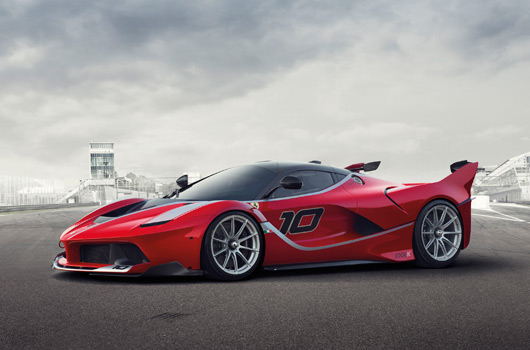
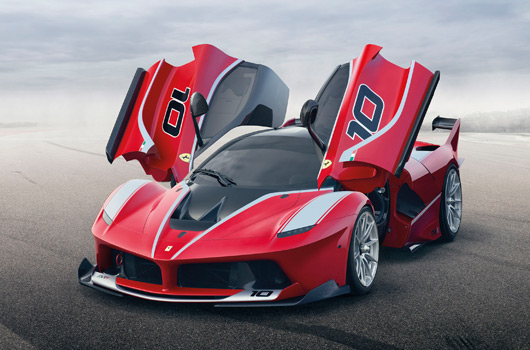
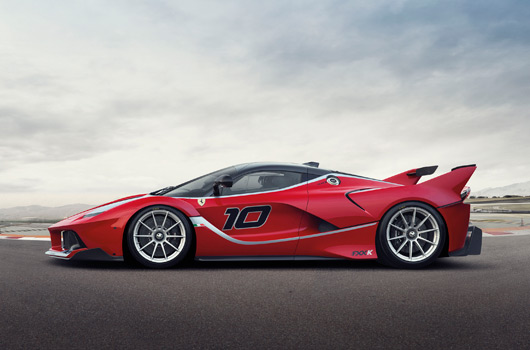
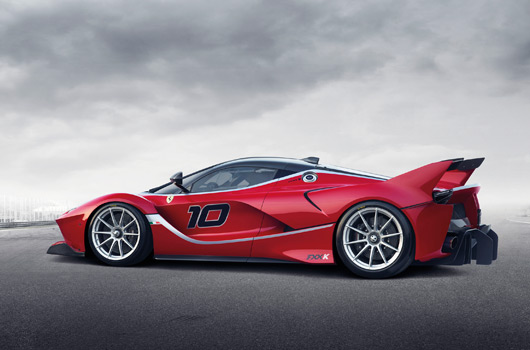
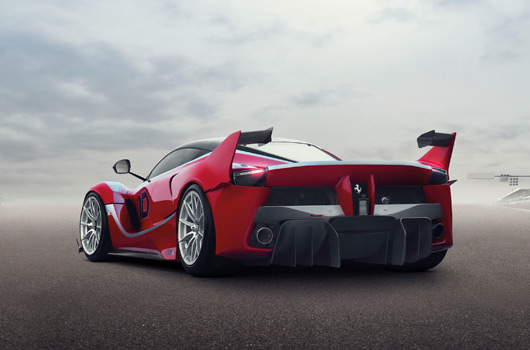
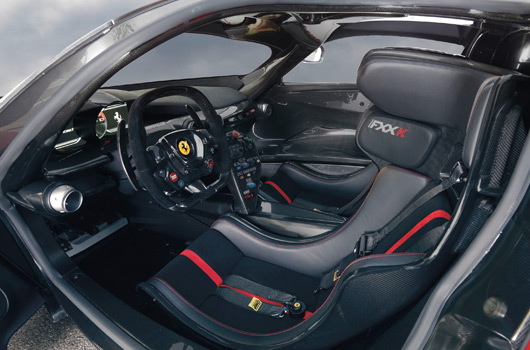

3 replies on “Ferrari FXX K revealed”
I keep on seeing the model as “Ferarri F**K”, which is probably about right if you actually got to drive one
Haha!
[…] obscenely named Ferrari FXX K made its debut at the Finali Mondiali show at the Yas Marina circuit in Abu Dhabi recently. After […]